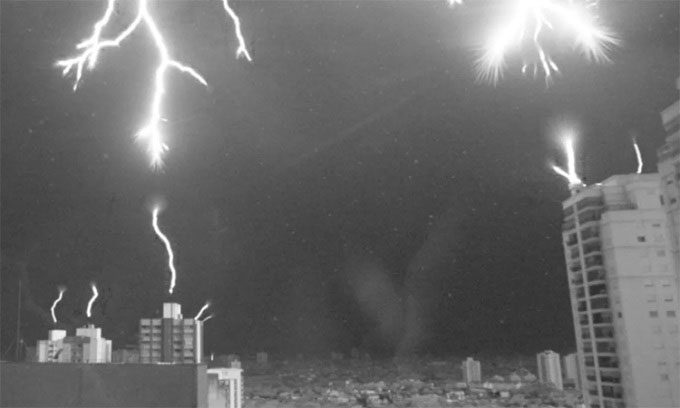The use of high-speed cameras to capture images of lightning strikes is an effective method for studying and understanding the phenomenon of lightning.
Marcelo Saba, a researcher at the National Institute for Space Research in Brazil (INPE), along with doctoral candidate Diego Rhamon, captured a rare photograph showing the connection between a lightning strike and nearby lightning rods, as reported by Interesting Engineering on March 14th. The new study was published in the journal Geophysical Research Letters.

Lightning rods attempting to connect with the downward electric flow. (Photo: Diego Rhamon/INPE).
To take the photograph, the research team used a high-speed camera system installed on the rooftops of tall buildings. The photo resulted from careful planning and a bit of luck, capturing the moment perfectly to reveal details about the lightning’s components. According to the research team, the image shows a negatively charged lightning bolt descending towards the ground at a speed of 370 kilometers per second.
“When the lightning is just tens of meters above the ground, the lightning rods and tall objects on the rooftops of nearby buildings emit positive discharges upwards, competing to connect with the downward lightning bolt,” Saba stated. The final photograph was taken 25 microseconds before the connection occurred, resulting in the lightning striking one of the buildings.
Saba began researching lightning using high-speed cameras in 2003, creating one of the largest databases of high-speed lightning videos.
The research team used cameras that capture 40,000 frames per second. This high-speed equipment allows them to assess the impact of such lightning strikes, especially in cases where adequate protective measures are lacking. In this instance, a fault in the installation system left the area exposed, and a 30,000-ampere current struck, causing significant damage.
There were a total of 31 channels of predecessors to lightning (also known as upward leaders) originating from the nearby buildings to prevent the negatively charged downward leaders, according to the research team.
Lightning can also be classified as negative or positive depending on the charge transmitted to the ground. Experts estimate that only 20% of lightning makes contact with the ground, while the rest remains confined within clouds.
The research team notes that such lightning bolts can extend up to 100 kilometers and carry a current of up to 30,000 amperes. “The temperature of a typical lightning bolt is 30,000 degrees Celsius, which is five times the surface temperature of the Sun,” Saba explained.
Lightning forms due to friction between ice particles, water droplets, and hail, releasing electrical charges and creating polarization between different cloud regions. Such potentials can range from 100 million volts to 1 billion volts. As the electrical charges seek the path of least resistance, lightning tends to branch, often zigzagging instead of following a straight path.
“The path of lightning is determined by the varying electrical characteristics of the atmosphere, which is not uniform,” Saba explained. The research team stated that lightning rods do not repel or attract electrical flows; they merely provide lightning with an easy and safe path to the ground.





















































